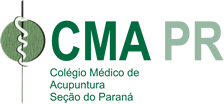14/04/2021 Ações do CMA-PR em prol da valorização da acupuntura |
Nesse ano de 2021 o CMA-PR iniciou negociação com a cooperativa Unimed Curitiba para obter um reajuste nos valores repassados aos acupunturiatras cadastrados.
Ao longo dos últimos anos, os valores das sessões não foram corrigidos adequadamente e atualmente estão abaixo dos valores praticados no mercado, de outras operadoras e até mesmo das demais Unimeds. Seguimos dialogando com a administração da Unimed Curitiba buscando a valorização do trabalho da acupuntura. |
|
|
02/10/2019 Exercício Profissional de Acupuntura |

Encerrando a agenda de hoje, com a visita do médico acupunturista, Endrigo Monte Serrat Prevedello, que esteve acompanhado do assessor do deputado Romanelli, Ronald Oliveira. Eles pediram apoio e uma atenção especial ao PL 1549/2003 que disciplina o exercício profissional de Acupuntura no país e determina outras providências. Atualmente a acupuntura não tem uma regulamentação em lei, mas é reconhecida como especialidade médica.
Segundo Endrigo, a classe médica é contra o Projeto do Dep Celso Russomano. No entanto, a Medicina Tradicional Chinesa não é lúdica ou mística... é MEDICINA, apenas com um olhar diferente. A acupuntura faz parte da Medicina Tradicional Chinesa, afirma o médico Prevedello.
|
|
|
03/10/2016 Sites de Referência em Acupuntura: |
AMERICAN ACADEMY OF MEDICAL ACUPUNCTURE
http://www.medicalacupuncture.org/
THE BRITISH MEDICAL ACUPUNCTURE SOCIETY
http://www.medical-acupuncture.co.uk/
THE WORLD FEDERATION OF ACUPUNCTURE - MOXIBUSTION SOCIETES
http://www.wfas.org.cn/en/
INTERNATIONAL COUNCIL OF MEDICAL ACUPUNCTURE AND RELATED TECHNIQUES
http://www.icmart.org/
DEUTSCHE AKADEMIE FÜR AKUPUNKTUR
http://www.akupunktur-patienten.de/ |
|
|
03/10/2016 Effects of the acupoints PC 6 Neiguan and LR 3 Taichong
on cerebral blood flow in normal subjects and in migraine patients |
Effects of the acupoints PC 6 Neiguan and LR 3 Taichong
on cerebral blood flow in normal subjects and in migraine patients
Abstract Acupuncture has been proven to be effective in the treatment of various cardiovascular disorders; it acts both on the peripheral flow and on the cerebral flow. Our study aimed to evaluate the effects of the insertion of PC 6 Neiguan and LR 3 Taichong acupoints on the cerebral blood flow (CBF) in the middle cerebral artery (MCA). These effects were measured in a group of patients suf- fering from migraine without aura (Group M) and in a healthy control group (Group C). In the study, we included 16 patients suffering from migraine without aura, classified according to the criteria of the International Headache Society, and 14 healthy subjects as a control group. The subjects took part in the study on two different days, and on each day, the effect of a single acupoint was evaluated. Transcranial Doppler was used to measure the blood flow velocity (BFV) in the MCA. Our study showed that the stimulation of PC 6 Neiguan in both groups results in a significant and longlasting reduction in the average BFV in the MCA. After pricking LR 3 Taichong, instead, the average BFV undergoes a very sudden and marked increase; subsequently, it decreases and tends to stabilize at a slightly higher level compared with the baseline, recor- ded before needle insertion. Our data seem to suggest that these two acupoints have very different effects on CBF. The insertion of PC 6 Neiguan probably triggers a vasodilation in MCA, while the pricking of LR 3 Taichong determines a rapid and marked vasoconstriction.
Neurol Sci (2014) 35 (Suppl 1) : S129–S133 |
|
|
03/10/2016 Acupuncture in cluster headache: four cases and review of the literature |
Acupuncture in cluster headache: four cases and review of the literature
Abstract Although cluster headache (CH) is the most disabling form of primary headache, little evidences regarding alternative and complementary therapies are available. Only few dated studies and some isolated cases are described. We describe four patients with CH treated with acupuncture as a preventive treatment, combined with verapamil or alone. All patients received acupuncture treatment twice/week for 2 weeks, then once/week for 8 weeks, and then once/alternate weeks for 2 weeks. According to Traditional Chinese Medicine the acupoints selected were: Ex HN-5 Taiyang, GB 14 Yangbai (both only on the affected side), GB 20 Fengchi (on both sides), LI 4 Hegu, LR 2 Xingjiang, SP 6 Sanyinjiao, ST 36 Zusanli (all on both sides). At each point, after the insertion of the needle, the feeling of ‘‘De Qi’’ was evoked; after obtaining this sensation the acupoints were not further stimulated for a period of 20 min, until their extraction. In all patients an interruption of cluster attacks was obtained. To our knowledge, this is the first report concerning acupuncture in CH patients which details the protocol approach, acu- points and duration of the treatment. Our results offer the opportunity to discuss the emerging role of acupuncture in the therapy of CH, assuming a possible influence on opioid system.
Neurol Sci (2014) 35 (Suppl 1):S195–S198 |
|
|
Registros 1 até 5 de 10
[1]
2
|
